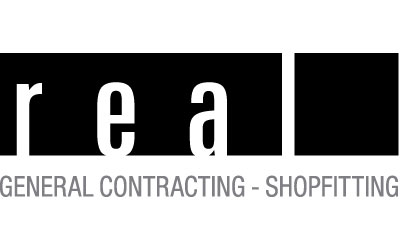The dynamics of the tenant-fit-out require a particularly sensitive and professional approach. Often the most diverse interests have to be agreed upon, conflicting scheduling concepts have to be taken into account and parallel projects have to be reconciled. Traditionally, particularly flexible project management as well as speed and reliability of the parties involved also play a decisive role in tenant improvements. It will come as no surprise to the reader of our publications that we at real Group consistently advocate responsible general contractors.
As design & build specialists, we stand for comprehensive interior fit-out in the context of tenant fit-out, including workplace organisation, occupancy planning, sampling and forward-looking project management from A to Z. Clients and their partners or landlords and tenants benefit from clean interface management, clear planning processes and a sense of reality that has grown out of concrete experience. Professional tenant fit-out is not just about knowledge and practical skills. It is about antifragility, to use the expression of Nassim Nicholas Taleb, the Advocatus Diaboli of futurology. Not buckling when the unexpected happens. Foresight and unemotional flexibility are actually the most important criteria of resilient professional tenant development.
Tenant fit-out: what it’s all about
Tenant fit-out is commonly understood to mean making a tenant’s premises ready for occupation. This includes, in particular, the classic interior fittings and tenant-specific equipment in rented spaces, as well as all structural measures that are carried out on the building in correlation. This includes both the removal of materials and any installation or conversion that takes place. Whenever the conversion or renovation of areas and rooms in differently used properties is involved, one speaks of a tenant fit-out. Many people will be familiar with the colloquial term tenant improvement. Rooms that are rented out are often in a raw state. If the tenant wants to change this, he needs the landlord’s authorisation to build out the interior on his own. The construction work is then done in the tenant’s own name and for his own account. Entrepreneurs are often tenants of office complexes, warehouses or premises for a business. When they take over the buildings, they are often empty and without a layout. Tenant construction then involves finishing the shell of the building. In terms of tenancy law, this is referred to as “renovations and alterations to the property”. This means that in addition to the room layout, painting, carpets, floors, windows, counters or fittings in bathrooms are also part of the improvements or renewals. The furniture is excluded from this.
What does the shell include?
The shell includes the entirety of all standard interior fittings, such as walls, ceilings and floors. However, not the surface treatment. In addition, the heating and cooling systems are counted as part of this. Pipes and controls may have to be laid. Toilets are also counted as part of the basic equipment. In some cases, only the plumbing and water pipes are included. Both the entrance door and windows are present. Depending on the use or special needs, they have to be adapted.
What improvements or renovations can be made?
- Adaptation of the floor plan and room layout
- Adaptation of doors, windows and fixtures
- Surface design and painting
- Sanitary fittings
- Floors, carpets
- Lighting
- Electricity, data and telephone connections
- Emergency exits, stairs, lifts
Flexible conversion
It often makes sense to convert existing premises instead of building new ones. The main advantage of tenant fit-out is that buildings or warehouses can be divided up as desired. This means that you can divide the premises individually according to your own needs or use. In this way, the rental property can be optimally adapted to the tenant. The tenant has the greatest possible freedom in the design. The conversion can be started flexibly and implemented on schedule. The conversion makes the rental property more attractive. In addition to the advantages for the tenant, the landlord also benefits from a tenant improvement. Financing is much easier for the landlord and he is relieved of the burden of building investments beyond the shell construction. In addition, there is hardly any planning and organisational effort.
Requirements for tenants and landlords
A prerequisite for a good, smooth implementation of tenant improvements are the equally important requirements for both the owner and the tenant. A particularly relevant point is the quick response time of both sides to mutual concerns. The owner is expected to handle the whole project professionally and to implement it quickly. In addition, the agreed budget for feasible projects and their structured planning must be adhered to in all areas. Tenants’ requirements are especially the consideration of individual space planning and appealing design concepts. In addition, an interior design and furnishing concept is desirable. For the tenant’s move-in and move-out, it is necessary to plan the action and carry it out in a structured manner. The façade design as well as the installation of advertising facilities also play an important role for the tenant. All in all, individual solutions should be found for both greening concept, maintenance cleaning and deconstruction.
Six cornerstones of successful tenant development
1. Plan effectively
With experienced planning, many complications can be avoided. It is particularly important to be aware of how much space is needed before renting space. It is important to plan ahead and think about future growth. An appropriate budget should be prepared based on the space requirements.
2. Discuss plans with the landlord
Already during the lease negotiations, it should be discussed with the landlord what changes or renovations are to be made. Furthermore, any disagreements should be resolved before signing the contract and starting construction. In addition, it is important to check whether the building can withstand the load of the construction work and the machinery required for it.
3. Protect equipment
A core problem of tenant improvement is that the raw construction rent is not regulated by law. Moreover, long-term leases can be terminated by the landlord. This can happen, for example, if the rental property is sold. Then the landlord has the option to terminate the tenancy with the purchaser due to urgent personal need. In addition, disputes may arise after termination of the tenancy if the interface between shell and tenant fit-out is not clearly defined. This is because often all permanently installed equipment counts as part of the building and must usually remain there. The lease agreement must therefore contain binding provisions on who has what rights and which party – tenant or landlord – has what claim to installed equipment, fittings, etc.
4. Focus on budgeting
General contractors work with fixed prices. General contracting means avoiding complex tenders and lengthy planning phases as well as confident coordination of the forces involved for clear budget statements. It is important to calculate the financial requirements and determine the amount of the budget before construction begins. In addition, all financing options should be examined.
5. Seek expert advice
If you have questions or problems, it is advisable to contact experts in tenant improvements. The real Group is always available with its many years of knowledge and specific expertise. As a general rule, cooperation with experts accelerates, facilitates and secures the entire fit-out process.
6. Continuous monitoring
It is critical to keep an eye on all work, planning and milestones as well as the budget at all times. In this way, flexible and professional countermeasures can be taken immediately in the event of errors.
Tasks of the project management
In addition to taking stock of the property on site, the project management’s tasks also include checking whether the project is technically and legally feasible. After assessing the tenant’s needs and analysing the technical requirements for the rental space, a cost plan must be drawn up. In addition, all necessary documents must be obtained and organised. Based on the requirements determined so far, the project management prepares a fit-out description and then the occupancy is planned.
Competences from different disciplines
Tenant fit-out is a complex matter that requires many different competences from different fields. Particularly important is the planning process, which requires a lot of organisational talent, because a conversion is always planned together with the client. Depending on the use or function of the location, e.g. as a warehouse, office space or even both combined, must be planned and implemented accordingly. The advantage of a combined location is that the contact person is directly on site and quickly available in case of problems. In addition, further rental costs for extra rooms are saved. Exactly such planning is necessary in order to precisely structure the practicable benefits and budgeting. In addition, attention must be paid to the infrastructure and logistics, provided there is storage space in the immediate vicinity. For shops or shops, the situation is somewhat different, but here too it requires precise planning in terms of location, budget, interior layout and infrastructure.
Tenant fit-out at real
Project-experienced, reliable, fast. We accompany our clients throughout the entire concept and workplace development process, right up to the finished tenant fit-out. The real Group provides professional support in finding ideas, in the planning process, in budgeting and in meeting deadlines. The focus is on finding an optimal solution together with our clients for rooms and interiors, floors and entire buildings that is tailored to individual needs and benefits. Design and technical requirements are not neglected either. Through our continuous monitoring, we offer a comprehensive overview throughout the entire process. Our vision is enthusiastic tenants and landlords: we work out an economically attractive service package for them. Clients benefit from our many years of know-how. We look forward to actively supporting new clients in their tenant development. If you are interested in the dynamics of tenant improvement, please contact us online via the contact form or simply call 09345-6720.




